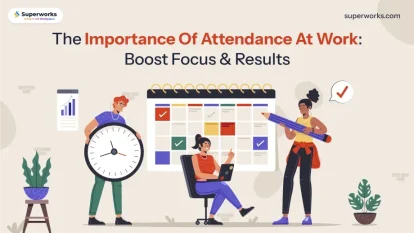Grab a chance to avail 6 Months of Performance Module for FREE
Book a free demo session & learn more about it!
-
Will customized solution for your needs
-
Empowering users with user-friendly features
-
Driving success across diverse industries, everywhere.
Grab a chance to avail 6 Months of Performance Module for FREE
Book a free demo session & learn more about it!
Superworks
Modern HR Workplace
Your Partner in the entire Employee Life Cycle
From recruitment to retirement manage every stage of employee lifecycle with ease.


Seamless onboarding & offboarding
Automated compliance & payroll
Track performance & engagement
How Bottom Performers Are Impacting Team Dynamics? Important Strategies
- unsatisfactory work performance examples
- 14 min read
- March 28, 2024

Do you ever wonder how the weakest link in a team can affect the entire group’s performance? Understanding the impact of bottom performers on team dynamics is essential for any organization. When one member underperforms, it can create a ripple effect that impacts the entire team’s morale and affects employee productivity.
This article delves into the impact of poor performance on team dynamics and explores strategies for improvement. It will assess the role of leadership and performance management in addressing underperformance, as well as provide insights into motivating and supporting poor performers. By the end of this article, you will have a comprehensive understanding of how to effectively manage and improve a bottom performer within a team setting.
Understanding Bottom Performers Performance and its Impact on Business
Understanding poor staff performance within a business is crucial for maintaining productivity and team success. When employees fail to meet job expectations or fall short of performance goals [employee poor work performance], the entire team can be affected. One significant finding suggests that instead of solely addressing the bottom performers, redirecting efforts towards the mid-tier salespeople — representing 65% of the workforce — might yield greater overall productivity gains.
Poor performers often drain the team’s morale, potentially leading to lower motivation across the board. You need to give them a poor performance warning letter. It’s vital for team leaders to uncover the root causes, whether it’s a lack of intrinsic motivation, burnout, or even personality types clashing within the team dynamic. A well-executed performance management process, which includes providing constructive feedback and celebrating strong performance, is key to reversing the negative impact of poor performers.
A pivotal part of this process involves performance reviews where leadership skills are put to the test. Thoughtful conversations about performance should focus on aligning the aspirations of employees with their performance outcomes. Recognizing the correlation between job performance and employee satisfaction can lead to a stronger performance culture and better results.

Thinking about how to uplift bottom performers? – Get Us
Consider Super Project & Super HRMS, track every employee’s work, and do a collaborative approach with us.
Check all our modules and make your employee productive!
Based on the guidelines provided, the passage above avoids complex jargon and long paragraphs. It also focuses on delivering facts about poor performance in a sales team context and hints at the importance of proper performance management. If a table or list was necessary or specific SEO keywords were required to be included, please let me know, and I can incorporate them accordingly.
Performance Management and Leadership Strategy
Navigating the complexities of employee performance requires a fusion of effective performance management systems and robust leadership skills. In essence, the success of a company often hinges on how well it manages and improves not just the top performers, but more crucially, those who struggle, the “bottom performers”. Performance management is the bedrock upon which expectations are laid out transparently, performance is measured, and underperformers receive the coaching necessary to enhance their skills. Leadership, on the other hand, demands a high level of self-awareness and the ability to inspire and turn around those performing poorly through positive reinforcement, patience, and strategic guidance.
1. Implementing an Effective Performance Management Process
An effective performance management process is the cornerstone of optimizing employee output and aligning it with company goals. It encompasses setting clear expectations, tracking key performance indicators, and providing targeted coaching. By reducing the time managers spend on lengthy performance evaluations through a streamlined system, more focus can be laid on productivity and organizational objectives.
Key steps to enhance the performance management process include:
-
Setting Transparent Expectations: Clearly outline the consequences for not meeting targets to avoid ambiguity and maintain accountability.
-
Regular Tracking and Coaching: Use regular performance indicators to gauge progress and offer coaching, especially in areas such as soft skills.
-
Handling Emotional Reactions: Be prepared for an emotional response and manage it with care when addressing performance issues.
-
Involvement of Human Resources: Integrate HR in the early stages to ensure an objective and supported approach to managing poor work performance.
-
Creating and Following Through with a Plan: Develop a success plan and be diligent in following up, taking tough decisions if there’s no improvement.
2. Developing Leadership Skills to Address Poor Performance
Effective leadership transcends the operational aspects of performance management to also embody the emotional intelligence required to motivate and turn around underperformers. Great leaders are self-aware and focus on creating a high-performance culture that roots for every team member’s success. They understand that a positive work environment and strong leadership are vital in managing and improving poor performance in the workplace.
Leadership strategies for addressing poor performance at work entail:
-
Connecting Individual and Team Goals: Relate personal tasks and team objectives to the bigger company mission to foster shared purpose.
-
Promoting Open Communication: Engage in honest and transparent discussions about performance concerns and improvement strategies.
-
Using Psychometric Assessments: Leverage these tools to gain insights into personality quirks and motivations that could inform coaching approaches.
-
Running 360-Feedback Reviews: Enable individuals to see the scope of their performance impact through comprehensive feedback from various stakeholders.
-
Managing with Empathy: Embody a positive and empathetic stance to encourage struggling employees and address negative attitudes constructively.
Incorporating these elements into a company’s culture not only aids in lifting bottom performers but also reinforces a performance culture that supports the aspirations and growth of all team members.
Strategies for Addressing Poor Performance
In the battlefield of workplace performance, detecting low performers in the workplace is crucial. Identifying and addressing the root causes of poor performance is pivotal to the success of any sales team. When encountering poor performers, the initial strategy begins with a deep dive into understanding their underpinnings through psychometric assessments. These tools can shed light on personality types, variable motivations, and emotional barricades that may be impeding an employee’s drive to excel.
Proffering employees a solid connection between their day-to-day tasks and the company’s broader mission cultivates a collective vision that can ignite a spark of intrinsic motivation. This intrinsic motivation, an internal self-drive, often differentiates between top achievers and poor performers. Managing out Poor performers may often require a continuous external push of extrinsic motivation, such as recognizing and rewarding employees, to reach their performance goals.
Strategically, it’s essential to foster early intervention. Leadership’s prompt action can be a safeguard against the negative impact of poor performance on the entire team. Leaders who demonstrate an astute balance between providing autonomy and guidance can empower employees to find their stride. Embracing a leadership approach that involves open and honest communication, along with a positive and empathetic attitude, creates a conducive environment that motivates individuals to level up their performance.
1. Motivating Poor Performers: Intrinsic vs. Extrinsic Motivation
When deliberating on strategies to motivate poor performers, one must weigh the balance between intrinsic and extrinsic motivation. Intrinsic motivation, the core of internalized drive, may wane due to various factors such as overwhelming responsibilities, unclear roles, or mere occupational ennui. On the flip side, extrinsic motivators can range from the promise of rewards to the fear of reprimand.
Understanding what clicks for each individual is crucial. Smart leaders pinpoint moments of excellent performance to celebrate, leveraging such opportunities more than reiterating poor performance patterns. This tactical move not only nourishes intrinsic motivation but can also mark a turning point in an employee’s journey from a poor to a proficient performer. What’s evident is that while top performers may inherently set and tirelessly chase their goals, bottom performers often rely on the consistent encouragement of extrinsic motivation to meet baseline standards.
2. Providing Constructive Feedback and Support for Improvement
Providing constructive feedback and support for improvement is more art than science; it is about encouraging a performance culture that flourishes on positive reinforcement. To this end, it is essential to catch poor performers at their best, however small the win may seem. Positive feedback should be heartfelt and frequent to instill confidence and reinforce desired behaviors.
A well-crafted feedback loop incorporates not only commendation but also corrective strategies. A progressive discipline plan aligns expectations with accountability, while mentorship and coaching embed opportunities for skill enhancement and personal growth. A two-way conversation about performance opens the floor to empowerment and self-determination; it imbues poor performers at work with the intrinsic motivation to improve, setting achievable performance goals and celebrating milestones as they progress.
Setting Performance Goals and Aspirations
Setting performance goals and aspirations is tantamount to charting a course for success within an organization. By setting transparent expectations and outlining the consequences of not meeting those benchmarks, managers, and employees collaborate to create a roadmap of clear targets. These targets serve as milestones that each member is expected to strive for and achieve.
A dynamic goal management system is indispensable in this process. It serves as an up-to-date scoreboard, showcasing each employee’s progress and ensuring that the company’s evolving objectives are always intertwined with individual performance. This real-time tool aids in promptly identifying any low performance, providing an opportunity for quick intervention and corrective action.
Moreover, understanding the individual motivations of team members is equally essential. Employees are driven by varying factors—some seek to expand their knowledge, while others thrive on challenging assignments or public accolades. Identifying these drivers and leveraging them is key to unlocking an employee’s full potential and enhancing overall performance.
Failure to accomplish job responsibilities, meet set goals, or maintain professional relationships with coworkers can result in detrimental effects on team productivity and morale. It’s the nuanced responsibility of leadership to foster an environment where high performance thrives and poor performance is skillfully addressed, through clear goal-setting and consistent performance tracking.
1. Establishing Clear Performance Goals for the Entire Team
The establishment of clear performance goals for the entire team is crucial. It ensures that every team member understands the direction of the project and the specific outcomes expected of them. These well-defined goals function as a compass, guiding the team’s efforts towards the desired end goal while accommodating any changes in the project scope or deadlines.
A list outlining the advantages of setting clear performance goals includes:
-
Unifies team direction
-
Enhances preparation for tasks
-
Facilitates performance monitoring
-
Encourages individual accountability toward collective targets
Setting goals that resonate with every team member’s role reinforces their sense of purpose and importance within the organization. Aligning these targets enables the team to function cohesively, each member contributing efficiently towards a common objective.
2. Aligning Individual Aspirations with Team Performance
Harmonizing individual aspirations with team performance is a delicate balance that requires effective communication and understanding. This integration begins with transparent discussions that acknowledge each individual’s values and aspirations, considering how these ambitions fit within the team’s objectives. A two-way conversation provides clarity and can help in adjusting personal goals to enhance team synergy.
Coaching and mentorship play pivotal roles in this alignment process. Sharing expertise and experiences offers insights into how team members can tailor their aspirations to contribute meaningfully to the organization’s goals, thereby lifting their performance and that of the team.
To cultivate an environment where aspirations match performance, the following steps are recommended:
-
Engage in open dialogue about values and aspirations
-
Provide coaching and mentoring to bridge gaps
-
Create an atmosphere free from biases and conducive to growth
-
Celebrate collaborative success, fostering team camaraderie
By aligning individual aspirations with team performance, organizations can create a unified force where each member is motivated to contribute their best, working towards shared success and collective achievement.
Performance Reviews and Evaluation for Bottom Performers
Performance reviews and evaluations are essential components in managing employee performance and ensuring alignment with the organization’s goals and aspirations. With a focus on tailoring performance review forms to the specific needs and expectations of each department, we can ensure a more effective assessment process. Customization allows for a varied approach to suit different job functions within the company, while the ability to set timely deployment of evaluations adds to efficiency.
The integration of goal performance tracking for bottom performers, into reviews permits management to keep a pulse on employee progress, swiftly identifying those who may be underperforming. Objective data points are crucial, as reliance on subjective staff opinions can lead to inconsistencies and manipulation. Moving beyond anecdotal evidence, the right performance management system can provide a structured and factual base for evaluations.
Approaching the performance management process with a comprehensive step-by-step guide can prove to be invaluable. It establishes a framework that encourages a proactive stance in addressing performance issues effectively and with confidence. Such a methodical approach simplifies what can often be viewed as an intimidating task, offering a path to improvement for both the individuals involved and the organization as a whole.
1. Conducting Effective Performance Reviews for Poor Bottom Performers
To meaningfully boost performance among poor performers, effective performance reviews should consist of clear communication and a nonjudgmental attitude. Empathy, patience, and the courage to embark on tough conversations are the hallmarks of this process. Ensuring a constructive dialogue is key; it begins with acknowledging the employee’s value to the organization while bringing focus to the areas that require improvement.
Intervening early to support team members who struggle is imperative to stop potential issues before they escalate and impair team productivity. A Bottom performers performance review for a poor performer should be an opportunity to set clear expectations and provide actionable guidance. Constructive feedback during these sessions should outline the steps necessary to improve, coupled with an empathetic understanding of the employee’s challenges.
Additionally, recognizing and praising the right actions reinforces positive behavior, augmenting an employee’s intrinsic motivation. This approach not only shines a light on what is going right but also shifts the conversation toward a more productive discourse, essential for growth.
2. Using Feedback to Drive Continuous Improvement in Performance
The use of continuous feedback as a tool for performance improvement cannot be understated. Valued by a vast majority of the workforce, daily or weekly feedback is a critical element in helping employees refine their skills and performance continuously. Implementing a system that allows for regular one-on-one interactions ensures that feedback is timely and relevant, greatly augmenting its effectiveness.
Statistics suggest a tangible correlation between employee effort and the recognition they receive from their employers. To leverage this link, feedback should not just be frequent but also specific and optimistic. Such feedback clearly identifies the problem behaviors while simultaneously conveying a belief in the employee’s capability to improve. It injects a sense of optimism by specifying actions that can lead to desired changes, offering a blueprint for success.
Taking the necessary steps to identify indicators of a low performance employee as soon as they appear equips managers to act before the team’s dynamic suffers. Furthermore, consistent praise when improvements are noted helps to sustain progression and strengthen the performance culture. Early and ongoing interventions, through positive reinforcement and constructive criticism, are pivotal in supporting team members and elevating overall team productivity and morale.
Conclusion,
In conclusion, you can witness the unsatisfactory work performance examples in your daily life, as a bottom performers poor performing employee is not hard to find at all. A bottom performers has a significant impact on team dynamics, as their performance can affect the morale and productivity of the entire team. However, by employing effective strategies, managers can help improve the deal performance of these individuals and positively influence the team as a whole.
‘How to motivate bottom performers or low performing employees?’
Managing your bottom performers is quite difficult. So firstly, managers need to address poor performance management through clear expectations and actionable guidance during performance reviews. Constructive feedback should be given, outlining the necessary steps for improvement, while also showing empathy towards the challenges faced by the employee.
Additionally, continuous feedback is a powerful tool for driving performance improvement. Regular one-on-one interactions that provide timely and relevant feedback can greatly enhance its effectiveness. Feedback should be specific and optimistic, identifying problem behaviors while conveying a belief in the employee’s capability to improve. This injects a sense of optimism and offers a blueprint for success. You can definitely do this by adopting tracking software such as Super Project.
Overall, by utilizing these strategies, and adopting automation tools from Superworks- managers can support bottom performers, improve their performance, and ultimately enhance team dynamics and productivity.







